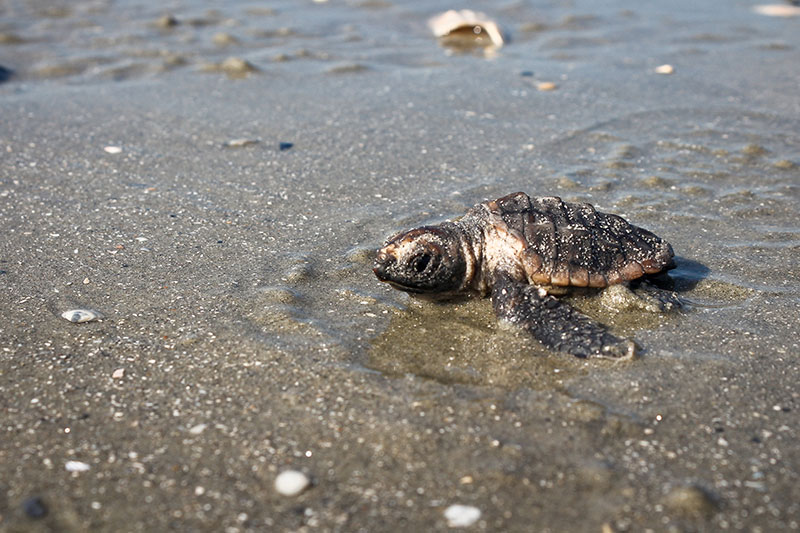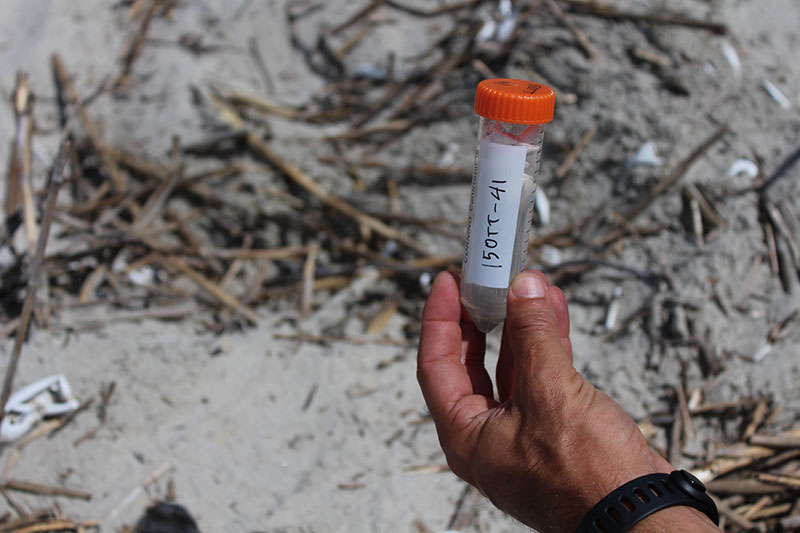October 22, 2020

October 31 marks the ‘official’ end of sea turtle nesting season, and with a few nests left to hatch, state biologists are pleased to report that sea turtles in South Carolina had a productive nesting season.
Preliminary estimates show sea turtles laid approximately 5,500 nests on South Carolina beaches, putting the year on par with nest counts in 2015 (5,109 nests) and 2017 (5,250 nests). Last year (the 2019 season) marked a tremendous departure from the norm regionally, with a record 8,797 nests laid in South Carolina. Female sea turtles do not nest every year, however, so fluctuations are expected from year to year. Overall, the 2020 numbers reflect an encouraging trend of increasing nest numbers along the southeastern coast as four decades of sea turtle conservation work begin to come of age.
The arrival of COVID-19 in South Carolina just before the start of nesting season forced an immediate shutdown of preseason activities. Eventually, staff and volunteers reworked their operating procedures to accommodate the new health crisis in time to catch the first sea turtle nest of the year, laid May 1 in the Cape Romain National Wildlife Refuge.
"It was touch and go at the beginning of the season," said SCDNR biologist Michelle Pate, who heads the agency's sea turtle nesting work. "We needed to determine how to engage our large volunteer networks in this important conservation work while ensuring we did not put their health at risk. As usual, our many dedicated volunteers rose to the challenge to collect another valuable season of data and ensure a successful outcome for nests."
COVID-19-related difficulties persisted through the season for some sea turtle teams, particularly on state and federal beaches such as those in Cape Romain, which represents the densest nesting area in the state. Working under federal restrictions, the already-limited staff there had to count, protect, and later inventory thousands of nests without the usual help of volunteers.
"Jerry Tupacz and Billy Shaw under the leadership of and alongside Sarah Dawsey continued to make miracles happen out at Cape Romain with the sea turtle project this year despite budget and staffing shortfalls, coupled with the additional challenges of 2020," Pate said. "These folks have an unwavering drive and focused mindset to get the business at hand done regardless of difficulties laid before them. The Refuge is a special and important area for sea turtles in the Northern Recovery Unit and we are indebted to them for their efforts."
Hurricane season presents a threat to sea turtle nests every year, and while coastal communities escaped largely unscathed in 2020, Hurricane Isaias impacted hundreds of nests north of Charleston in early August. Overall, an estimated 16% of the state’s nests were lost this year to high tide events ("King Tides") and storms, including Isaias.
Egg-loving predators such as coyotes, raccoons and, increasingly, armadillos also took their toll on a fair number of nests, primarily on more remote beaches where volunteers and staff were unable to patrol daily.
The 2020 nesting season also held a few interesting surprises.
Through a genetics project that has been ongoing for over a decade with University of Georgia researcher Dr. Brian Shamblin, staff and volunteers collect DNA samples from almost every nest laid each year. Sequencing of these samples allows researchers to identify the individual females that lay each nest, as well as important family relationships.
"It was a "wild" nest on North Myrtle Beach that turned out to be a Kemps, considered "wild" because volunteers did not observe it until the hatchlings emerged," Pate said. "Volunteers there monitor the beach seven days a week, but the wind likely obscured the initial tracks in the sand – Kemps crawls tend to be lighter since they are smaller turtles than loggerheads, so the nesting mother's impression in the sand disappeared fast."
The genetics project also revealed an even rarer visitor to South Carolina's coast – a loggerhead-hawksbill hybrid sea turtle. While loggerheads are the state's most common sea turtles (as well as the state reptile), hawksbill sea turtles are rarely seen in state waters and have never nested here. This hybrid female laid a nest on Cape Island early in the summer. Her appearance was fascinating news for staff, but unfortunately, Hurricane Isaias destroyed her nest, spoiling an opportunity for biologists to learn more about hybrid sea turtles.
"I have documented these hybrid turtles in areas of Florida where foraging hawksbills are common," Dr. Shamblin wrote. "But this is a first north of Florida, as far as I am aware."

Media Contact:
Regional Public Information Coordinator
Erin Weeks at
WeeksE@dnr.sc.gov
843.610.0096



